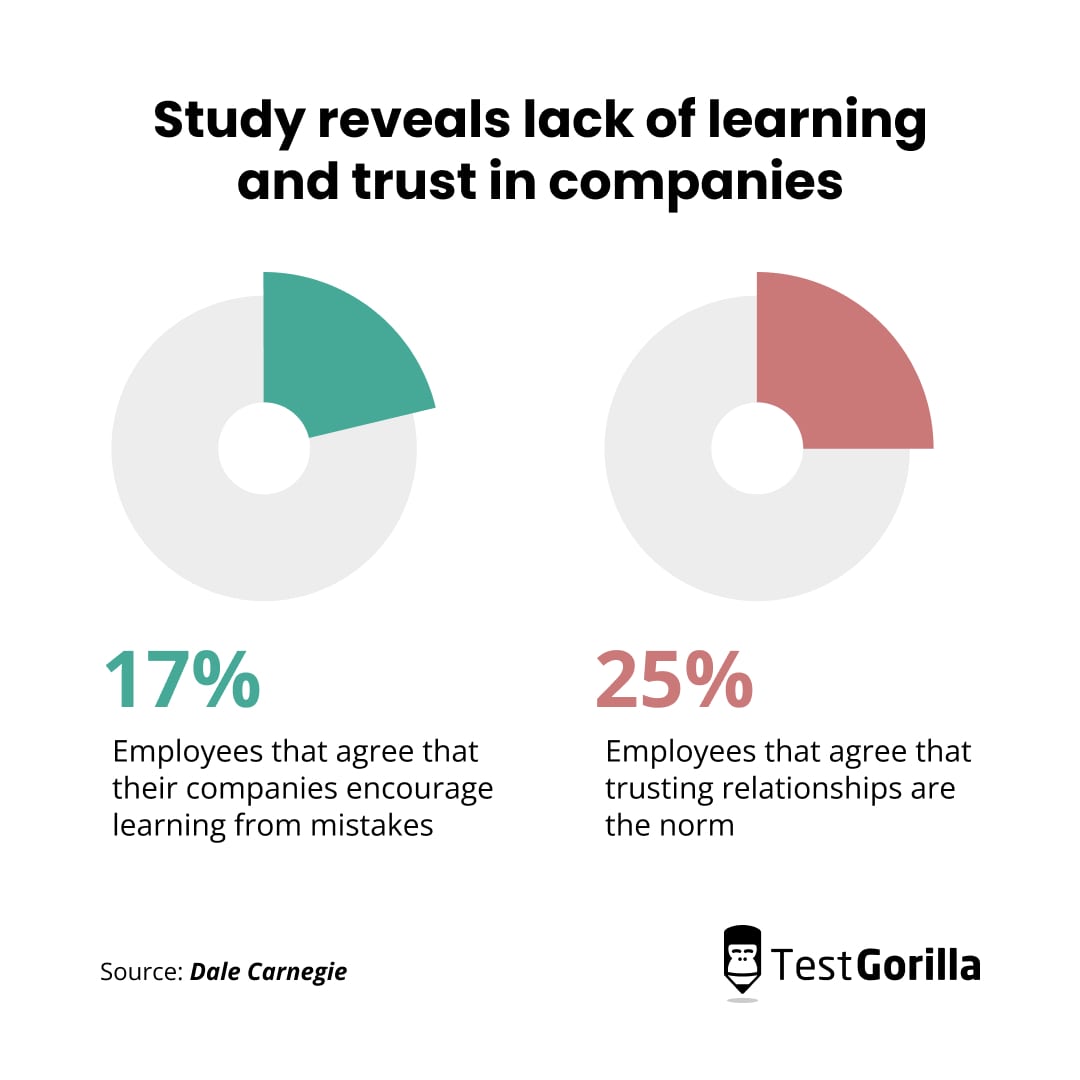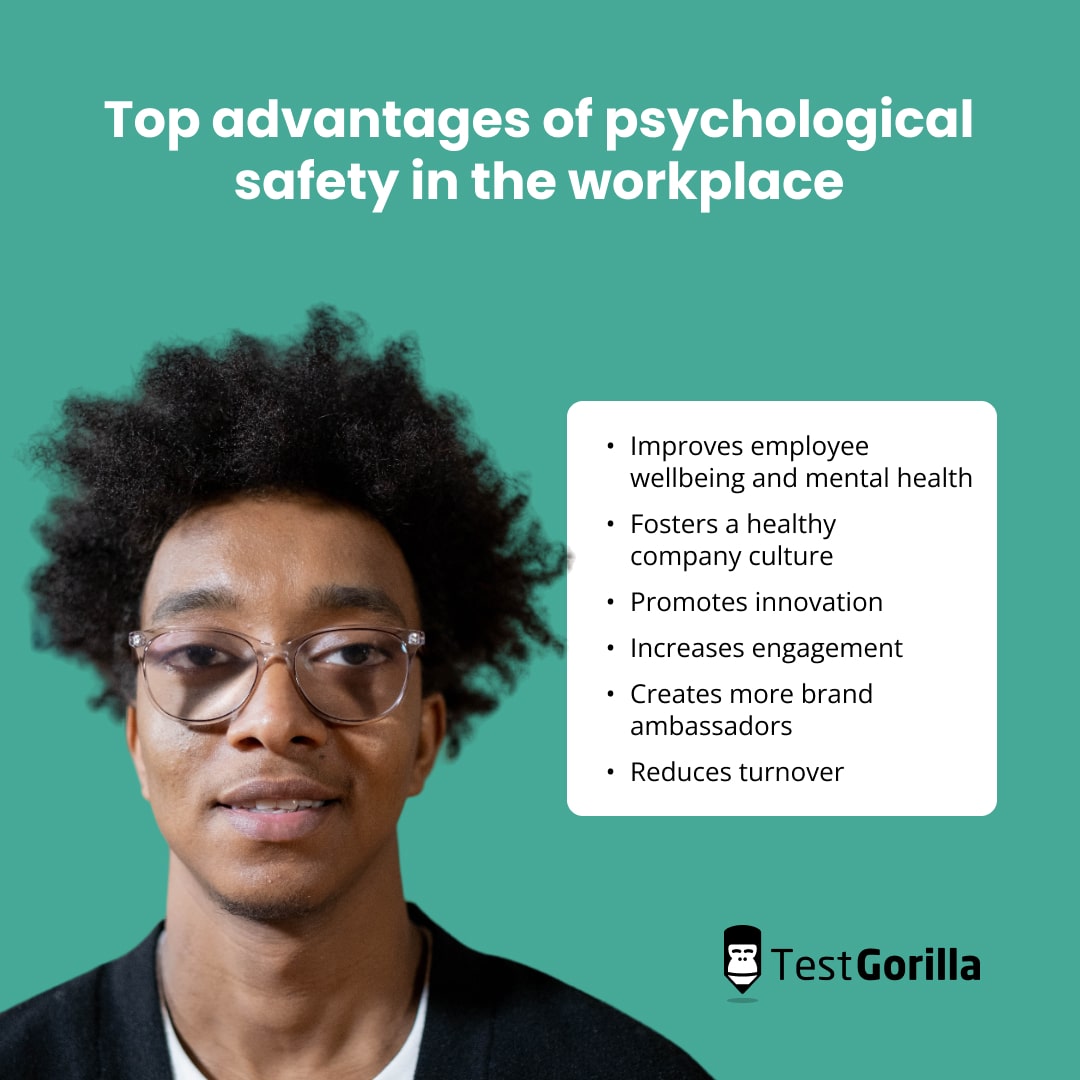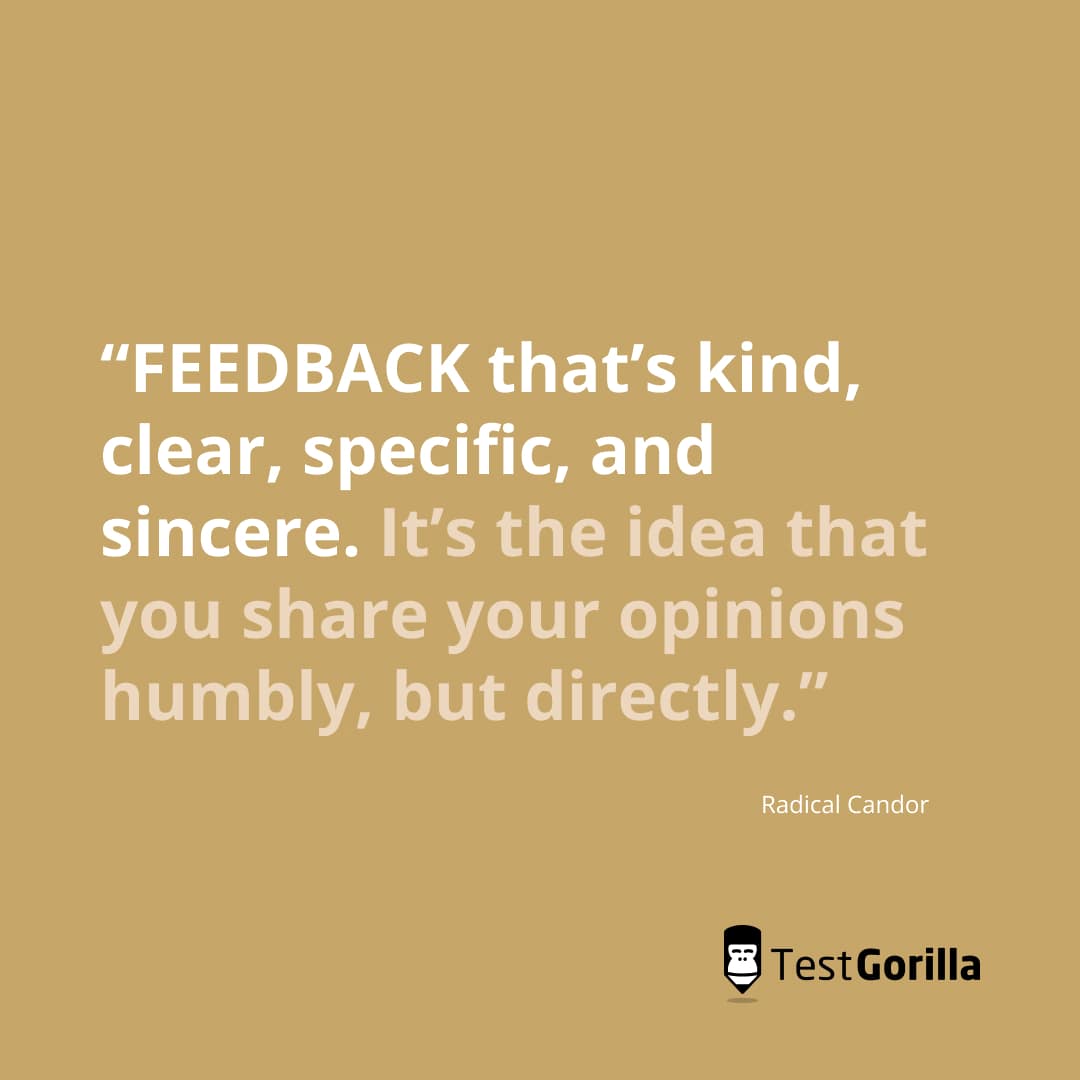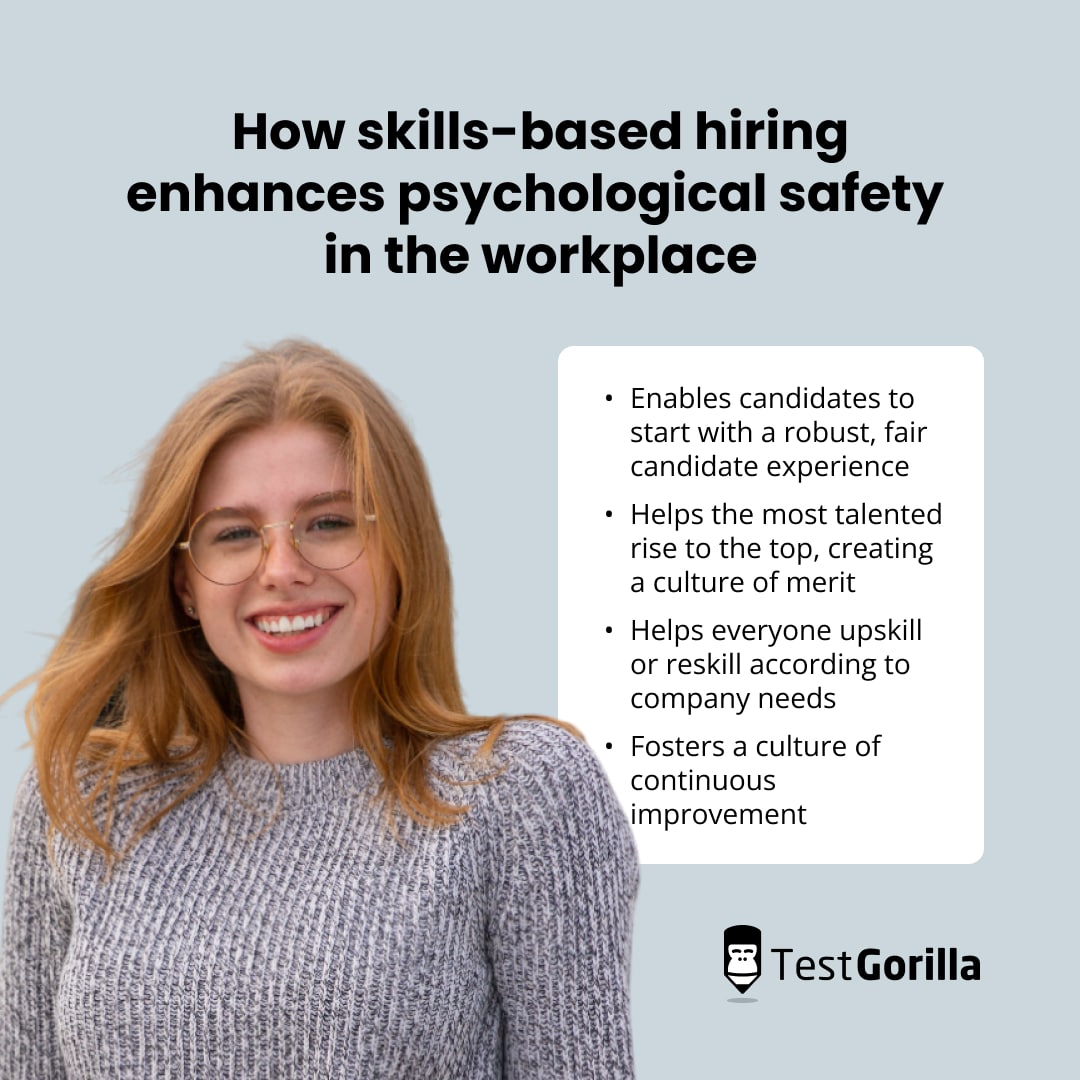Psychological safety at work is a major concern in the current landscape. Only one in five employees feel comfortable sharing constructive criticism in their workplace.[1]
Even worse, countless big-name leaders believe the best way to inspire their workforce is through fear.[2]
This is not only regrettable from a compassionate, human point of view – it’s a detriment to your company’s success.
A study from the UK showed that 828,000 workers suffered from work-related stress, anxiety, or anxiety from 2019 to 2020, resulting in the loss of 17.9 million working days.[3]
Modern organizations need to strive to create a safe place where people want to work. Employees need to be a part of a healthy company culture where they’re free to learn, make mistakes, and speak freely.
In this blog, we discuss the importance of psychological safety, its benefits, and how you can build a safer workplace for your people.
Table of contents
- What is psychological safety at work?
- The benefits of psychological safety in the workplace
- The negative effects of a lack of psychological safety in the workplace
- How to build psychological safety at work: 9 ways HR professionals can contribute to a safe, positive environment
- Psychological safety at work is the only way forward
- Sources
What is psychological safety at work?
Psychological safety at work is when employees feel comfortable and safe making mistakes, taking risks, and being themselves.
It means your workers feel free to open up about concerns, ask questions, share opinions, propose ideas, or admit mistakes without fear of ridicule or negative consequences.
We wish we could say that this environment is typical, but there’s an unfortunate lack of psychological safety in the workplace.
According to a study by Dale Carnegie, a minuscule 17% of employees strongly agree that their companies encourage learning from mistakes, and only 25% agree that trusting relationships are the norm.[1]
According to Timothy R. Clarke, the author of “The Four Stages of Psychological Safety,” there are four distinct stages of psychological safety that teams go through.
Let’s take a look at them:
Inclusion safety: In the first stage, an employee feels safe and accepted being who they are, with no harassment or judgment from colleagues
Learner safety: The second stage is when an employee feels safe learning, making mistakes, and asking questions
Contributor safety: Here, an employee feels confident enough to contribute their ideas and skills
Challenger safety: Once the final stage is reached, an employee feels secure enough to question the status quo if they see an opportunity for positive change
These stages show a clear progression of confidence and security, and the more comfortable your team members feel, the more innovation and better team performance your company sees.
Psychological safety examples
It’s much easier to grasp the concept of psychological safety in the workplace when we look at real examples.
Let’s look at a few psychological safety examples, comparing a toxic environment to a psychologically safe one:
Scenario 1: A junior publisher publishes a blog earlier than scheduled, causing a minor scheduling conflict.
Toxic workplace: The publisher’s superiors get furious, yell at them, tell them “not to let it happen again,” and wordlessly take away some of their responsibilities as hidden punishment.
Psychologically safe workplace: The publisher’s superiors respectfully discuss the error with them. They then tell them that this is an opportunity to learn and to pay special attention to publishing dates.
Scenario 2: A new content strategist proposes an idea that the agency has already implemented.
Toxic workplace: The strategist’s colleagues laugh at them and tell them the idea is “obvious.” This discourages future ideas and brainstorming.
Psychologically safe workplace: The strategist’s colleagues tell them that it’s a good idea – that’s why they’re already using it! They then encourage them to continue this innovation.
Scenario 3: A client has decided not to buy a product due to an inexperienced sales representative.
Toxic workplace: The sales rep’s manager and team give them the cold shoulder, silently removing other clients from their roster.
Psychologically safe workplace: The sales rep’s manager gives them some solid coaching, their team reassures them that it happens to everyone, and the rep is encouraged to keep going.
Did you notice a theme among the safe environments?
Psychological safety at work means encouragement, support, and the ability to make mistakes and learn from them.
One study showed that happy workers are 13% more productive, and it’s easy to see why.
An employee may feel immense pressure to be perfect, but that doesn’t magically make them flawless in their work. This pressure only causes anxiety, employee burnout, and resentment.
On the other hand, when an employee feels safe to explore, be themselves, and learn, it brings amazing benefits.
The benefits of psychological safety in the workplace
Psychological safety at work benefits both employers and employees.
Employees want to feel safe and confident to learn and ask questions, and employers benefit tenfold from high-performing teams full of happy, innovative workers.
Here are the top advantages of psychological safety in the workplace:
Benefit | Description |
Improves employee well-being and mental health | Employees that have the freedom to explore and make mistakes have severely reduced anxiety and burnout |
Fosters a healthy company culture | Companies with an inclusive, safe environment build a positive, attractive company culture |
Promotes innovation | Employees that feel safe to make mistakes and question the status quo are more likely to offer suggestions and creative ideas |
Increases engagement | Employees have higher engagement and morale in a safe space, leading to higher performance and better quality work |
Creates more brand ambassadors | Employees are much more likely to promote your company and speak about you in a positive light when your environment is healthy and positive |
Reduces turnover | Employee retention greatly improves when they’re secure in their workplace |
The benefits can be even more powerful to a distributed workforce.
Psychological safety at work is essential in hybrid offices and remote companies where it’s more complex and nuanced to build healthy, effective teams.
A safe environment and a cohesive culture take a little more work to get perfect, but it’s worth it (we’ll talk more about this later).
The negative effects of a lack of psychological safety in the workplace
The presence of security and psychological safety brings many benefits to a company – but it’s more than that.
The lack of psychological safety in the workplace has a detrimental impact on your organization, damaging teamwork, trust, and employee engagement.
Here are a few ways that a toxic, oppressive environment affects your company:
Negative impact | Description |
Damages trust | A lack of psychological safety harms . For example, Google’s abrupt, careless handling of recent layoffs damaged the trust of its current workforce. |
Discourages innovation and new ideas | Employees that aren’t able to make mistakes or ask questions won’t bother trying in the future, reducing overall innovation and creative problem-solving. |
Causes burnout and quiet quitting | Employees that have no feeling of security may shut down, undergo intense burnout and simply stick to doing the bare minimum, which is also known as . |
Causes quick quitting | A toxic environment is the and causes quick quitting, also known as when an employee leaves an organization before their one-year mark. |
Causes | Unsafe workplaces have a deep impact on employees that could stay with them for years, affecting their work at their current company and many to come. |
Damages brand image | Toxic environments can severely damage your company’s image. One example is Google, mentioned above, which many are saying used to have a “pristine” working reputation before a round of recent layoffs. |
A lack of psychological safety in the workplace can even negate the benefits of other initiatives.
It’s well-known that the benefits of diversity in your workforce include enhanced innovation and creativity.
But one study from Daan van Knippenberg and Michaéla C. Schippers found that diversity doesn’t lead to increased innovation on its own unless a workplace also provides psychological safety.[4]
This diverse talent won’t feel confident to share their great new ideas until they feel supported in being themselves, taking risks, and speaking out.
We think all of this is a strong indicator that a psychologically safe workplace isn’t just “nice-to-have” but a necessity in today’s working landscape.
How to build psychological safety at work: 9 ways HR professionals can contribute to a safe, positive environment
We don’t have to accept toxic environments as a fact of life.
There’s so much that your HR department can do to create psychological safety at work and build a healthy, innovative culture.
Summary
Strategy | Description |
Make psychological safety a priority for your organization | Adopt psychological safety as a core value and have your leaders live and breathe it |
Nurture empathy in the workplace | Foster healthy empathy in your culture by leading from the top and coaching your managers |
Practice honesty at work | Encourage open feedback, honesty, and constructive criticism |
Be open, tolerant, and respectful of individual differences | Support diversity and promote inclusion by respecting differences and offering accommodations |
Focus on your people’s skills and not their connections or pedigree | Adopt skills-based hiring to show your people that you prioritize their talent, not workplace politics |
Allow your employees to experiment and fail | Create a culture where failure is safe, normal, and acceptable, increasing innovation and security |
Build a process for dealing with toxic behaviors | Make a stand against toxic behaviors and discourage them whenever possible |
Embrace productive conflicts in the workplace | Let your people know that conflict is normal and help them resolve it in a healthy way |
Take special care of psychological safety for your remote/hybrid employees | Pay attention to your remote workforce, prioritizing communication and ensuring no one gets left behind |
1. Make psychological safety a priority for your organization
One of the first steps to creating a psychologically safe work environment is to make it a company value.
This means adopting a culture of psychological safety from the top: Gain executive support for a positive environment and ensure they live by this attitude and encourage it in others.
Your leaders are pivotal because employees follow their behavior – if they’re vulnerable and human, people will notice.
There are some amazing leaders out there living and breathing these values, and their companies are seeing the benefits.
Melissa Bernstein, a co-founder and chief executive of Melissa and Doug, inspired her employees with her openness about her mental health struggles and depression.
The Melissa and Doug brand now encourages safety and mental health as primary brand values, going as far as creating a free “mental health hub” called LifeLine.
Another leader who inspired his workforce with his passion and humanity is Parag Agrawal, former CEO of Twitter, who made headlines when he took paternity leave in 2022.
Moves like this inspire and encourage positive behaviors in your entire workforce – and possibly beyond, because Parag’s inspired countless men in other companies to feel comfortable taking paternity leave.
Employees appreciate what their leaders think and how they act. When your leadership adopts compassionate values and shows what makes them human, the effects reverberate throughout the whole organization.
2. Nurture empathy in the workplace
Empathy in the workplace is the ability to understand the emotions of others. It’s a spectrum ranging from simply being aware of someone’s feelings to feeling them yourself.
Workplace empathy is essential for a psychologically safe environment. It provides people with much-needed support, makes them feel valued and heard, and helps with employee burnout.
When a company has an empathetic culture, its employees feel a strong inclusion and understanding.
Here are a few ways that HR can build more empathy in the workplace:
Hire people high in empathy and compassion
Encourage an empathetic company culture
Reward empathetic behavior
Encourage open-door policies and communication
Practice active listening
Commit to being an inclusive workplace
Lead by example and display open empathy yourself
This last point is essential. If you lead with empathy in your daily interactions, your people follow, and you create an empathetic culture naturally.
This applies to HR managers and line managers alike.
It’s unfortunate that 60% of chief executives believe their organizations are empathetic, although only 39% of Gen Z workers perceive their leaders as empathetic.
This shows a noticeable gap between how leaders believe they present themselves and how those under them perceive them.
It’s important for these changes to start from the top. A positive culture flourishes if you curb manipulative, or passive-aggressive, behaviors in leaders and managers.
For more insights, read our blog on empathy in the workplace.
3. Practice honesty at work
An environment based on honesty and transparency is imperative for psychological safety.
This creates a culture where everyone feels comfortable speaking their minds – because everyone is.
This is linked to the concept of radical candor: feedback that’s kind, clear, specific, and sincere. It’s the idea that you share your opinions humbly, but directly.
This means promoting a culture of feedback, constructive criticism, and coaching. Coaching is a crucial part of healthy honesty and kindness, while still challenging your people.
We recommend regular 1:1 meetings, on a weekly or biweekly basis. These 1:1s should focus on good and bad feedback, employee goals, and even how the company can improve in the employees’ eyes.
You should have these 1:1s and coaching sessions with line managers, too. Discuss psychological safety at work, so they know:
How to behave within a psychologically safe framework
Why it’s important
That they’re fully supported by their organization
Building trust and honesty as a foundation of your workplace is one of the biggest steps toward creating a workplace where people feel safe and accepted.
4. Be open, tolerant, and respectful of individual differences
It’s non-negotiable to be respectful of differences, diversity, and neurodiversity.
This one might seem obvious at first, but bias and intolerance can be sneaky.
For example, Steve makes an offhand “joke” about Dahlia struggling to read the employee manual. But Dahlia has dyslexia and struggles reading long-form content.
This comment wasn’t a joke to Dahlia. It was impactful and painful, and it discouraged her from speaking about her difficulties in the future.
Inclusion is the first stage of psychological safety, and it’s vital to promote acceptance and respect.
Here are a few ways you can do it:
Offer accommodations and support
Never mock differences
Show respect for different opinions
Encourage different ideas
One of the factors affecting the autism spectrum disorder (ASD) employment gap is judgment, misinformation, and bias.
Countless workers are bullied or pigeonholed into roles they aren’t suited to because of this conscious and unconscious bias.
Standing up for differences and diversity is a huge step in improving psychological safety at work. For more information, read our blog on disability inclusion in the workplace.
5. Focus on your people’s skills and not their connections or pedigree
Prioritize your employee’s skills, capabilities, and what they contribute to the team.
Focusing on work politics, like connections and pedigree, only contributes to toxic environments.
Adopting skills-based hiring is a powerful way to tell your people that you care about their skills and talent – not experience with “good” companies or how popular they are in the office.
Skills-based hiring helps psychological safety in quite a few ways:
Enables candidates to start with a robust, fair candidate experience
Helps the most talented rise to the top, creating a culture of merit
Helps everyone upskill or reskill according to company needs
Fosters a culture of continuous improvement
This final point is particularly important.
Skills-based practices instill a feeling of continuous development in an employee, where they’re always eager to grow, learn from their mistakes, and improve.
A focus on development and improvement encourages employees to seek out learning opportunities and crave upskilling and reskilling.
This eventually culminates in a flourishing culture where workers want to learn and every member of the team is always improving.
This ties into our next point.
6. Allow your employees to experiment and fail
Allow your employees to take risks, make mistakes, and learn from them. If they’re afraid to experiment and speak their minds, they’ll never feel entirely safe.
This freedom improves your team’s innovation and decision-making. Team members know that failure isn’t severely penalized, so they’re much more likely to make suggestions and throw out new ideas.
You can encourage this mindset by shaping your culture around learning and improving, not perfection.
Try creating a “fail of the week” channel on your group chat, where employees can self-submit fails to promote a work culture where failure is normal and human.
Encourage managers and leaders to post on this channel. This relates to our earlier point. When employees see their leaders engaging in this interpersonal risk-taking, making mistakes and laughing them off, it makes them feel relaxed and secure.
7. Build a process for dealing with toxic behaviors
Learn to deal with toxic behaviors and don’t let them slip by unnoticed.
Often, a lack of psychological safety in the workplace doesn’t have one big flashing red light as its underlying cause. It’s simply the result of toxic behaviors being tolerated or ignored.
What do we do about it? Don’t accept toxic behaviors as a fact of life. Be proactive and nip this behavior in the bud.
Here are a few tips for reducing negative behaviors in your workforce:
Discuss toxic behaviors during 1:1 meetings
Implement coaching and mentoring
Implement courses on workplace behavior
Encourage employees to report toxic behavior
Encouraging your people to report toxic behavior is crucial. This has the dual effect of not only zeroing in on negative behavior but also letting them know that their feelings and employee experience matter to you.
For more information on how to curb toxic behavior, read our article on how to avoid the asshole genius.
8. Embrace productive conflicts in the workplace
Productive conflict is an aspect of a healthy workplace. It’s much different from the aggressive conflict that makes a work environment negative and toxic.
Embrace productive conflicts at work and help your people get through them with respect and positivity.
Work conflict is going to happen. It doesn’t just happen in big, screaming arguments. It’s a fact of work life, and it comes in many varieties:
Personality conflict
Task-based conflict
Working style conflict
Leadership conflict
It’s important for everyone to learn that conflict isn’t the end of the world. When you embrace productive conflict, it tells employees that opinions clashing is a normal part of life and that they can handle it without it getting out of hand.
You can do this by practicing and encouraging nonviolent communication. This tactic tosses out “coercive language” – any language that’s designed to make someone feel afraid, guilty, or ashamed.
This enables you to remove distractions, accurately clarify the cause of the conflict, and resolve it efficiently.
Nonviolent communication focuses on each party expressing themselves and taking the time to ensure every party understands what’s being said.
Focusing on clarity and removing any coercive language empowers conflicts to be resolved in a healthy, positive way.
For more on the subject, check out our in-depth guide on nonviolent communication.
9. Take special care of psychological safety for your remote/hybrid employees
Remote work and hybrid workplaces have become even more common since the pandemic, and these workforces need special attention when it comes to psychological safety.
Communication is more distant, check-ins can be few and far between, and a lot can be lost with less socialization and reduced body language. This can even lead to working from home depression.
It may sound dramatic to say that remote workers are “forgotten,” but it isn’t far from the truth. One study showed that 42% of supervisors admit to sometimes forgetting remote workers when assigning tasks.
Don’t misunderstand us – this isn’t the only point for remote workforces. All of the above tips still apply to remote workplaces. It may be even more important to be conscious of factors like empathy, positive leadership, and curbing toxic behavior.
What are a few remote-specific ways to improve psychological safety in the workplace?
Here are a few strategies:
Make it easy for employees to ask for feedback and encourage it
Make time for meaningful conversations during a team meeting or weekly huddle
Ensure time zones don’t get in the way by having asynchronous chat channels like Slack
Encourage vulnerability and honesty
This last point is incredibly important. Struggling employees are even harder to detect remotely.
It’s shocking that almost 60% of employees say they never discuss their mental health at work, and nearly half report that the reception was negative when they did.
An employee could be struggling with childcare or studies, and if you open up, they might, too.
For a deep dive into this subject, read our blog on remote psychological safety.
Psychological safety at work is the only way forward
Psychological safety isn’t a “bonus” at work. At the end of the day, a work environment where employees feel valued and secure is the only kind that attracts and retains modern workers.
It’s non-negotiable, and workers need it to stay productive, happy, and engaged.
Don’t let toxic behaviors slip under the radar, and prioritize empathy, honesty, and a focus on skills above work politics.
Looking to improve your organizational culture? Read our guide to cultural assessment and improvement for more information.
To start improving your workplace culture one hire at a time, use our Big 5 test to evaluate a candidate’s openness, conscientiousness, extroversion, agreeableness, and emotional stability.
Sources
Related posts
Hire the best candidates with TestGorilla
Create pre-employment assessments in minutes to screen candidates, save time, and hire the best talent.
Latest posts
The best advice in pre-employment testing, in your inbox.
No spam. Unsubscribe at any time.

Hire the best. No bias. No stress.
Our screening tests identify the best candidates and make your hiring decisions faster, easier, and bias-free.
Free resources
This checklist covers key features you should look for when choosing a skills testing platform
This resource will help you develop an onboarding checklist for new hires.
How to assess your candidates' attention to detail.
Learn how to get human resources certified through HRCI or SHRM.
Learn how you can improve the level of talent at your company.
Learn how CapitalT reduced hiring bias with online skills assessments.
Learn how to make the resume process more efficient and more effective.
Improve your hiring strategy with these 7 critical recruitment metrics.
Learn how Sukhi decreased time spent reviewing resumes by 83%!
Hire more efficiently with these hacks that 99% of recruiters aren't using.
Make a business case for diversity and inclusion initiatives with this data.























